Fluorescence Enhanced Optical Resonator Constituted of Quantum Dots and Thin Film Resonant Cavity for High-Efficiency Reflective Color Filter
Abstract
:1. Introduction
2. Materials and Methods
2.1. Design Principles of Fluorescence Enhanced Optical Resonator
2.2. Preparation of Fluorescence Enhanced Optical Resonator
3. Results and Discussion
3.1. Characterization of Quantum Dots
3.2. Metal–Dielectric Fluorescence Enhanced Optical Resonator
3.3. All-Dielectric Fluorescence Enhanced Optical Resonator
4. Conclusions
Supplementary Materials
Author Contributions
Funding
Institutional Review Board Statement
Informed Consent Statement
Data Availability Statement
Conflicts of Interest
References
- White, D.L.; Taylor, G.N. New absorptive mode reflective liquid-crystal display device. J. Appl. Phys. 1974, 45, 4718–4723. [Google Scholar] [CrossRef]
- Wang, X.; Lau, W.; Wong, K. Display device with dual emissive and reflective modes. Appl. Phys. Lett. 2005, 87, 113502. [Google Scholar] [CrossRef]
- Liu, H.; Yang, H.; Li, Y.; Song, B.; Wang, Y.; Liu, Z.; Peng, L.; Lim, H.; Yoon, J.; Wu, W. Switchable All-Dielectric Metasurfaces for Full-Color Reflective Display. Adv. Opt. Mater. 2019, 7, 1801639. [Google Scholar] [CrossRef]
- Lee, J.-H.; Zhu, X.; Lin, Y.-H.; Choi, W.K.; Lin, T.-C.; Hsu, S.-C.; Lin, H.-Y.; Wu, S.-T. High ambient-contrast-ratio display using tandem reflective liquid crystal display and organic light-emitting device. Opt. Express 2005, 13, 9431–9438. [Google Scholar] [CrossRef] [PubMed] [Green Version]
- Zhao, Y.; Xie, Z.; Gu, H.; Zhu, C.; Gu, Z. Bio-inspired variable structural color materials. Chem. Soc. Rev. 2012, 41, 3297–3317. [Google Scholar] [CrossRef]
- Lee, Y.; Park, M.-K.; Kim, S.; Shin, J.H.; Moon, C.; Hwang, J.Y.; Choi, J.-C.; Park, H.; Kim, H.-R.; Jang, J.E. Electrical broad tuning of plasmonic color filter employing an asymmetric-lattice nanohole array of metasurface controlled by polarization rotator. Acs Photonics 2017, 4, 1954–1966. [Google Scholar] [CrossRef]
- Taguchi, H.; Enokido, M. Technology of color filter materials for image sensor. Red 2017, 10502, 3216. [Google Scholar]
- Hong, J.; Chan, E.; Chang, T.; Fung, T.-C.; Hong, B.; Kim, C.; Ma, J.; Pan, Y.; Van Lier, R.; Wang, S.-g. Continuous color reflective displays using interferometric absorption. Optica 2015, 2, 589–597. [Google Scholar] [CrossRef]
- Tan, M.; Lin, Y.; Zhao, D. Reflection filter with high reflectivity and narrow bandwidth. Applied Optics 1997, 36, 827–830. [Google Scholar] [CrossRef] [PubMed]
- Xu, T.; Wu, Y.-K.; Luo, X.; Guo, L.J. Plasmonic nanoresonators for high-resolution colour filtering and spectral imaging. Nat. Commun. 2010, 1, 59. [Google Scholar] [CrossRef] [PubMed]
- Jang, J.; Badloe, T.; Yang, Y.; Lee, T.; Mun, J.; Rho, J. Spectral modulation through the hybridization of mie-scatterers and quasi-guided mode resonances: Realizing full and gradients of structural color. ACS Nano 2020, 14, 15317–15326. [Google Scholar] [CrossRef]
- Wu, Q.; Zhou, M.; Shi, J.; Li, Q.; Yang, M.; Zhang, Z. Synthesis of water-soluble Ag2S quantum dots with fluorescence in the second near-infrared window for turn-on detection of Zn (II) and Cd (II). Anal. Chem. 2017, 89, 6616–6623. [Google Scholar] [CrossRef] [PubMed]
- Fu, Y.; Gao, G.; Zhi, J. Electrochemical synthesis of multicolor fluorescent N-doped graphene quantum dots as a ferric ion sensor and their application in bioimaging. J. Mater. Chem. B 2019, 7, 1494–1502. [Google Scholar] [CrossRef] [PubMed]
- Fan, Z.; Zhou, S.; Garcia, C.; Fan, L.; Zhou, J. pH-Responsive fluorescent graphene quantum dots for fluorescence-guided cancer surgery and diagnosis. Nanoscale 2017, 9, 4928–4933. [Google Scholar] [CrossRef] [PubMed] [Green Version]
- Yukawa, H.; Baba, Y. In vivo fluorescence imaging and the diagnosis of stem cells using quantum dots for regenerative medicine. Anal. Chem. 2017, 89, 2671–2681. [Google Scholar] [CrossRef]
- Matea, C.T.; Mocan, T.; Tabaran, F.; Pop, T.; Mosteanu, O.; Puia, C.; Iancu, C.; Mocan, L. Quantum dots in imaging, drug delivery and sensor applications. Int. J. Nanomed. 2017, 12, 5421. [Google Scholar] [CrossRef] [Green Version]
- Chen, W.; Wang, K.; Hao, J.; Wu, D.; Wang, S.; Qin, J.; Li, C.; Cao, W. Highly efficient and stable luminescence from microbeans integrated with Cd-free quantum dots for white-light-emitting diodes. Part. Part. Syst. Charact. 2015, 32, 922–927. [Google Scholar] [CrossRef]
- Nielsen, D.; Chuang, S.; Kim, N.; Lee, D.; Pyun, S.; Jeong, W.; Chen, C.; Lay, T. High-speed wavelength conversion in quantum dot and quantum well semiconductor optical amplifiers. Appl. Phys. Lett. 2008, 92, 211101. [Google Scholar] [CrossRef]
- Lightcap, I.V.; Kamat, P.V. Fortification of CdSe quantum dots with graphene oxide. Excited state interactions and light energy conversion. J. Am. Chem. Soc. 2012, 134, 7109–7116. [Google Scholar] [CrossRef]
- Chen, Y.-J.; Lee, C.-C.; Chen, S.-H.; Flory, F. Extra high reflection coating with negative extinction coefficient. Opt. Lett. 2013, 38, 3377–3379. [Google Scholar] [CrossRef]
- Kang, Z.; Liu, Y.; Tsang, C.H.A.; Ma, D.D.D.; Fan, X.; Wong, N.B.; Lee, S.T. Water-soluble silicon quantum dots with wavelength-tunable photoluminescence. Adv. Mater. 2009, 21, 661–664. [Google Scholar] [CrossRef]
- Wang, H.C.; Lin, S.Y.; Tang, A.C.; Singh, B.P.; Tong, H.C.; Chen, C.Y.; Lee, Y.C.; Tsai, T.L.; Liu, R.S. Mesoporous silica particles integrated with all-inorganic CsPbBr3 perovskite quantum-dot nanocomposites (MP-PQDs) with high stability and wide color gamut used for backlight display. Angew. Chem. Int. Ed. 2016, 55, 7924–7929. [Google Scholar] [CrossRef] [PubMed]
- Pålsson, L.O.; Monkman, A.P. Measurements of solid-state photoluminescence quantum yields of films using a fluorimeter. Adv. Mater. 2002, 14, 757–758. [Google Scholar] [CrossRef]
- Deppe, D.; Lei, C.; Lin, C.; Huffaker, D. Spontaneous emission from planar microstructures. J. Mod. Opt. 1994, 41, 325–344. [Google Scholar] [CrossRef]
- Cao, F.; Wang, S.; Wang, F.; Wu, Q.; Zhao, D.; Yang, X. A layer-by-layer growth strategy for large-size InP/ZnSe/ZnS core–shell quantum dots enabling high-efficiency light-emitting diodes. Chem. Mater. 2018, 30, 8002–8007. [Google Scholar] [CrossRef]
- Kim, J.H.E.; Chrostowski, L.; Bisaillon, E.; Plant, D.V. DBR, Sub-wavelength grating, and Photonic crystal slab Fabry-Perot cavity design using phase analysis by FDTD. Opt. Express 2007, 15, 10330–10339. [Google Scholar] [CrossRef] [Green Version]
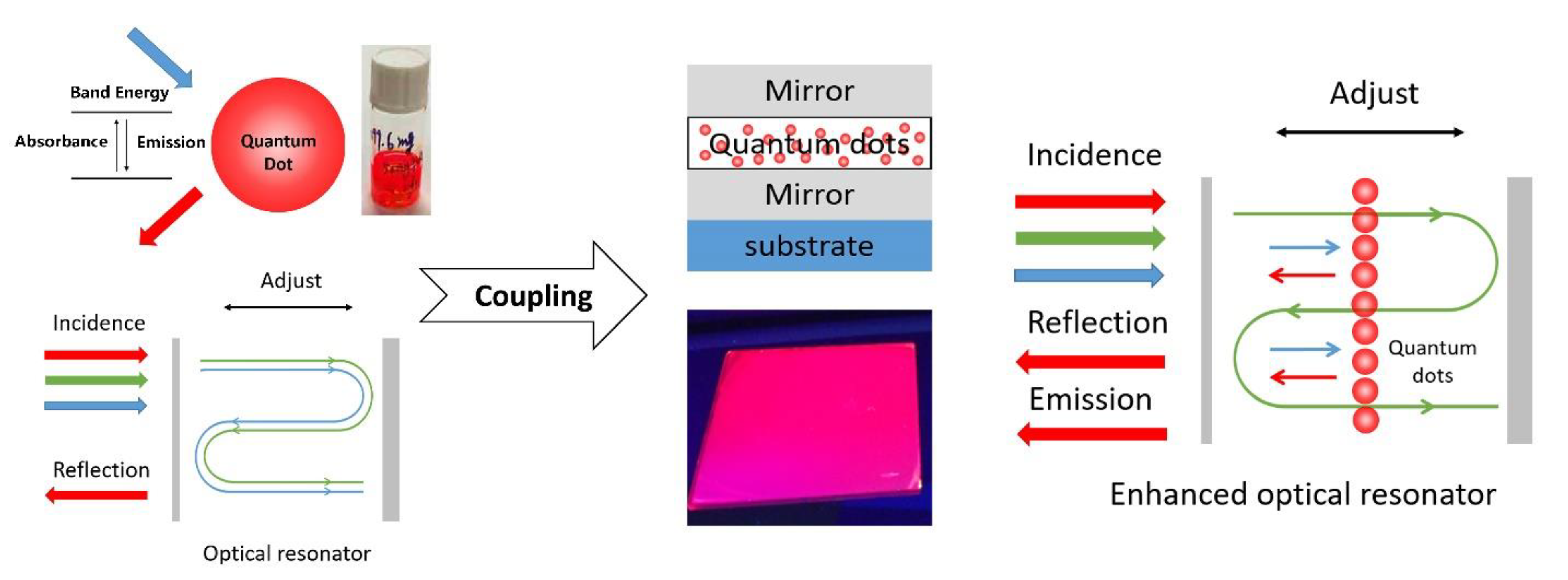
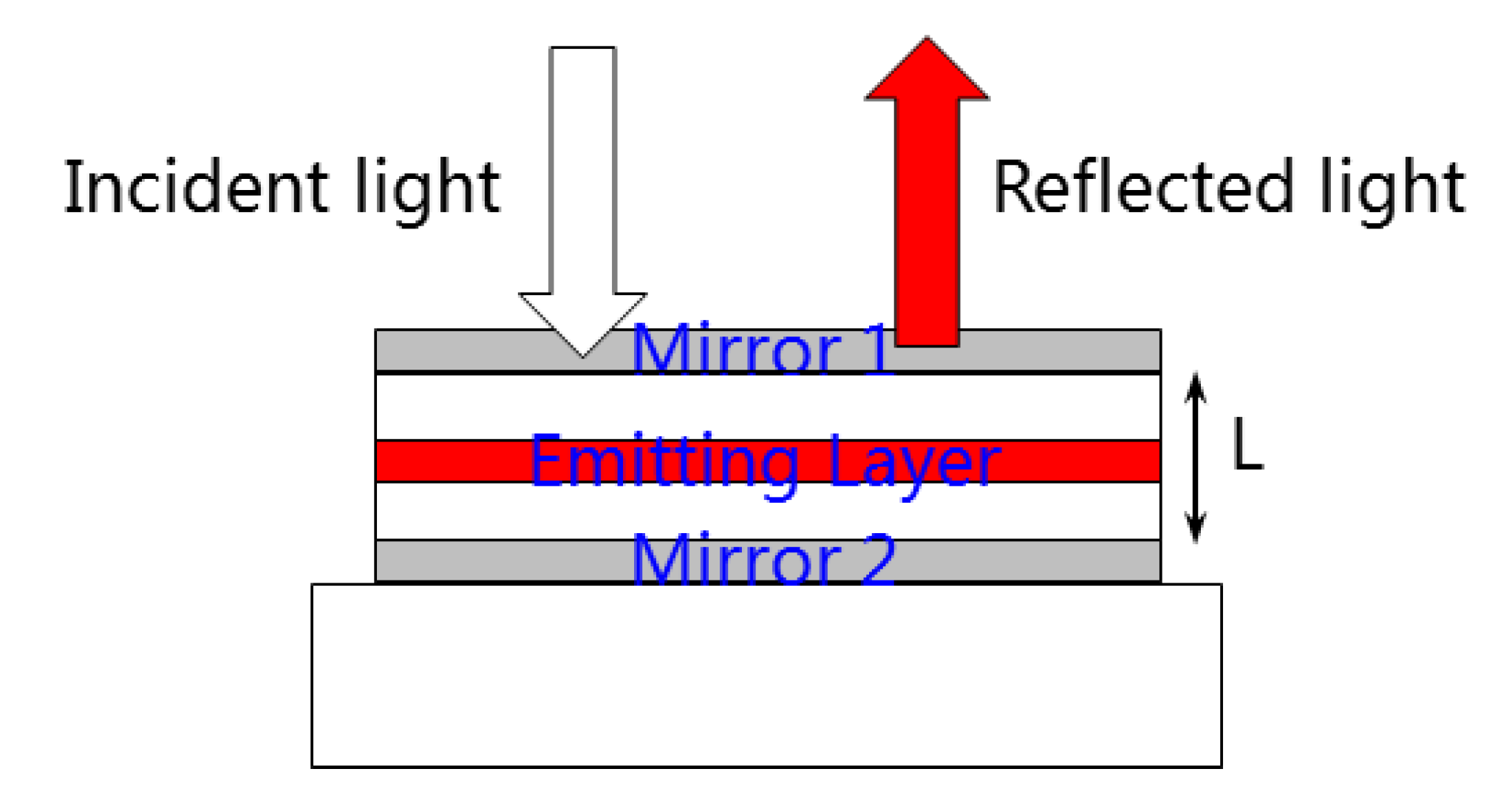



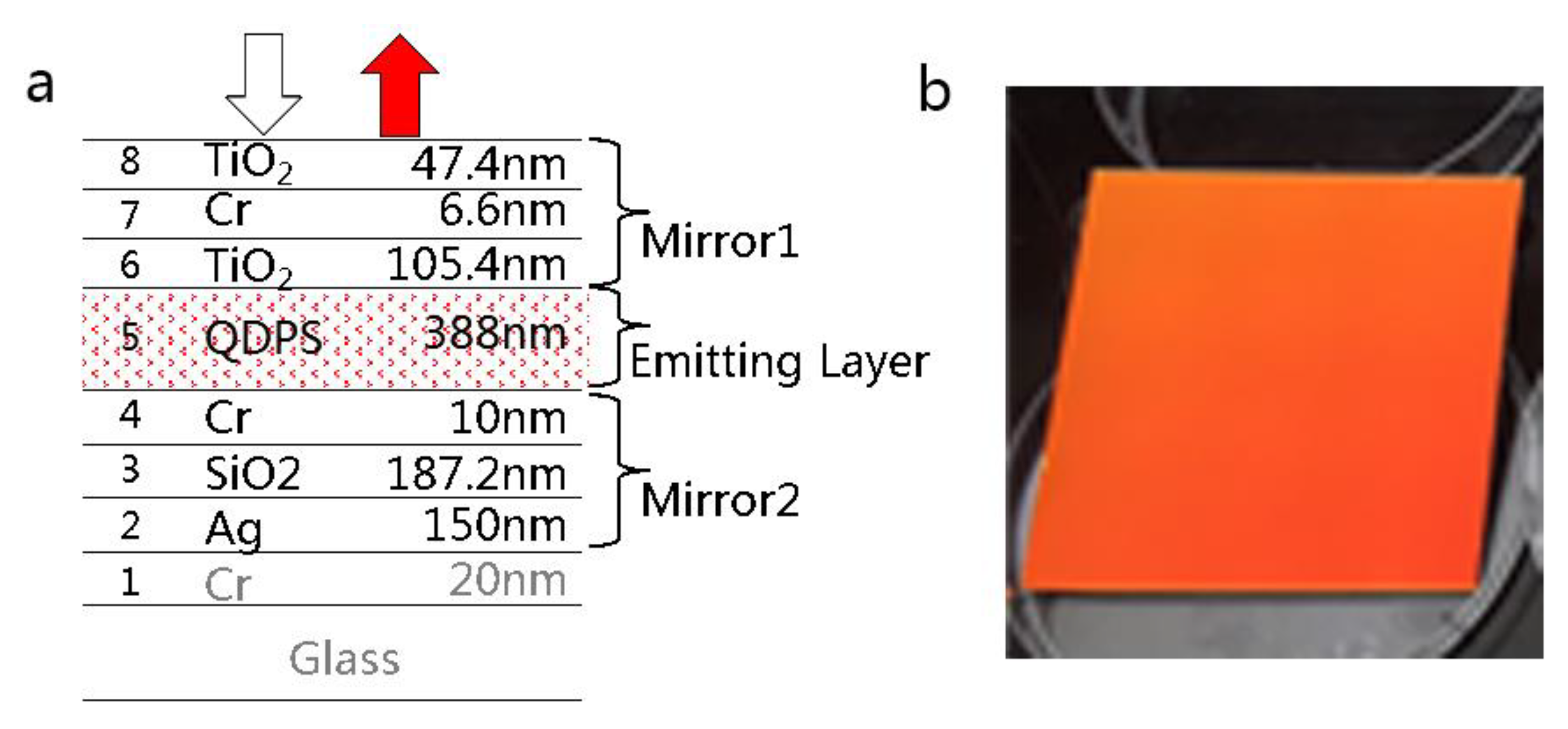

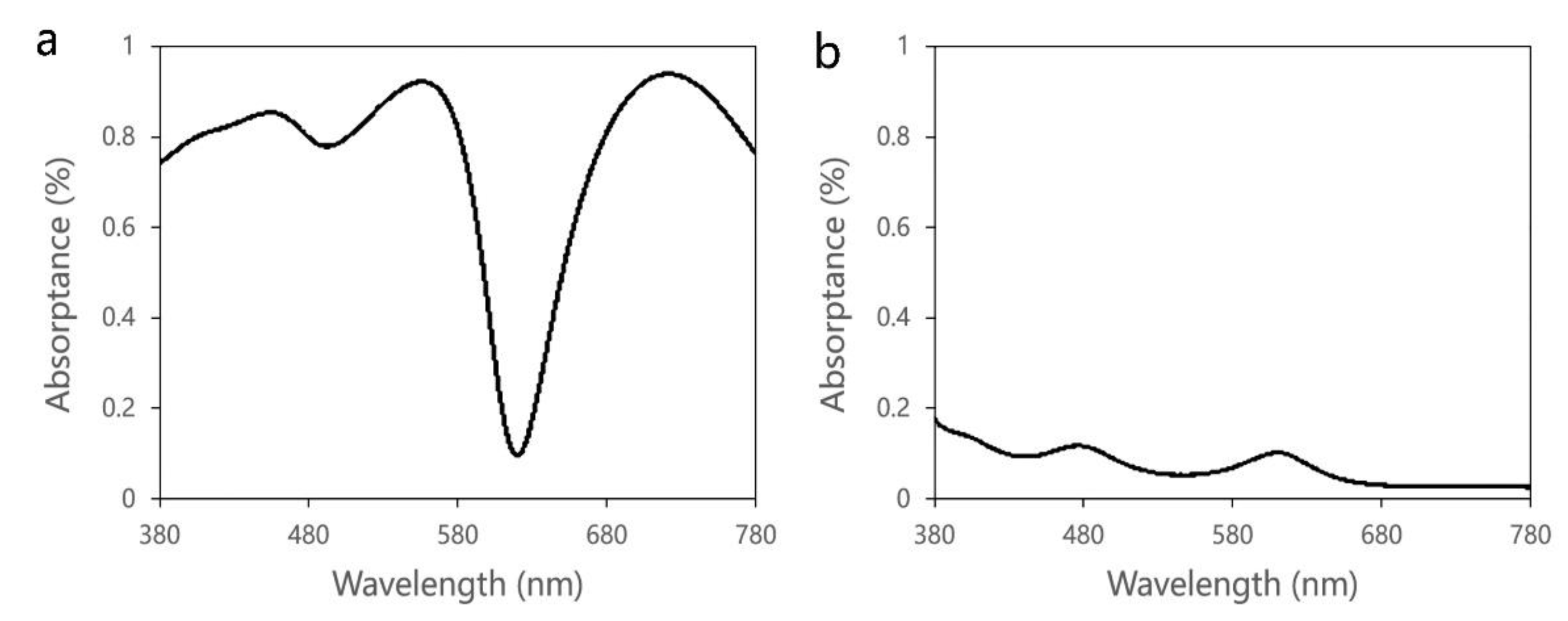



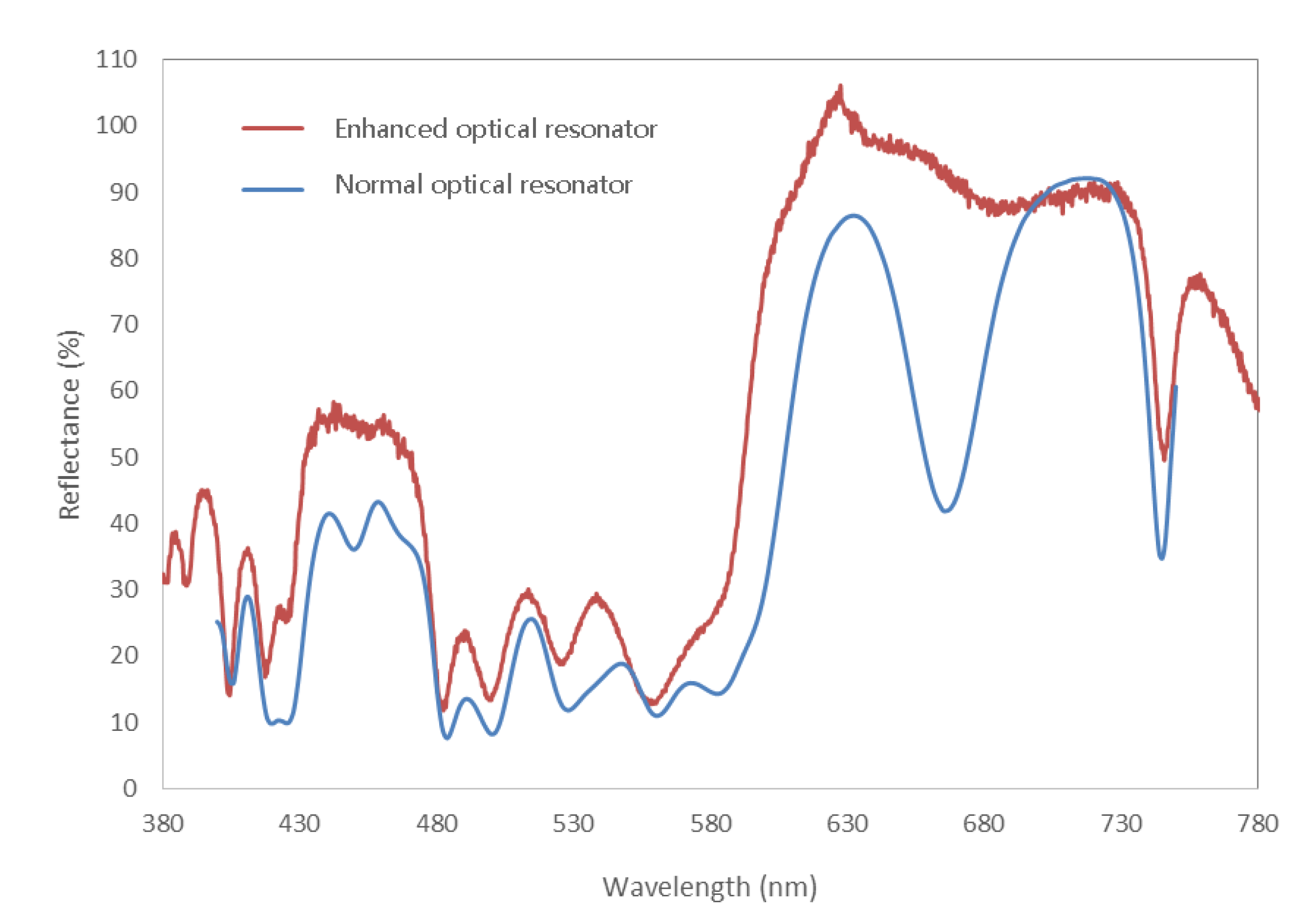
Publisher’s Note: MDPI stays neutral with regard to jurisdictional claims in published maps and institutional affiliations. |
© 2021 by the authors. Licensee MDPI, Basel, Switzerland. This article is an open access article distributed under the terms and conditions of the Creative Commons Attribution (CC BY) license (https://creativecommons.org/licenses/by/4.0/).
Share and Cite
Chen, X.; Liang, P.; Wu, Q.; Tan, Q.; Dong, X. Fluorescence Enhanced Optical Resonator Constituted of Quantum Dots and Thin Film Resonant Cavity for High-Efficiency Reflective Color Filter. Nanomaterials 2021, 11, 2813. https://doi.org/10.3390/nano11112813
Chen X, Liang P, Wu Q, Tan Q, Dong X. Fluorescence Enhanced Optical Resonator Constituted of Quantum Dots and Thin Film Resonant Cavity for High-Efficiency Reflective Color Filter. Nanomaterials. 2021; 11(11):2813. https://doi.org/10.3390/nano11112813
Chicago/Turabian StyleChen, Xiaochuan, Pengxia Liang, Qian Wu, Qiaofeng Tan, and Xue Dong. 2021. "Fluorescence Enhanced Optical Resonator Constituted of Quantum Dots and Thin Film Resonant Cavity for High-Efficiency Reflective Color Filter" Nanomaterials 11, no. 11: 2813. https://doi.org/10.3390/nano11112813
APA StyleChen, X., Liang, P., Wu, Q., Tan, Q., & Dong, X. (2021). Fluorescence Enhanced Optical Resonator Constituted of Quantum Dots and Thin Film Resonant Cavity for High-Efficiency Reflective Color Filter. Nanomaterials, 11(11), 2813. https://doi.org/10.3390/nano11112813




